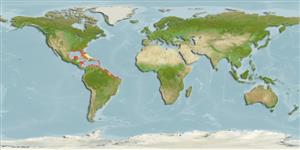>
Gobiiformes (Gobies) >
Gobiidae (Gobies) > Gobionellinae
Etymology: Gobionellus: Diminutive of Latin, gobius = gudgeon (Ref. 45335).
More on author: Pallas.
Environment: milieu / climate zone / depth range / distribution range
Ökologie
seewasser; süßwasser; brackwasser demersal; amphidrom (Ref. 46888). Tropical; 11°C - 29°C (Ref. 97140); 37°N - 36°S, 98°W - 34°W
Western Atlantic: USA (Virginia) to southern Brazil; occasionally taken as far north as Great Bay estuary, New Jersey; including Mississippi Sound, Gulf of Mexico off Port Aransas, Texas; the muddy coast of French Guiana and especially common along the lower Cayenne River.
Size / Gewicht / Alter
Maturity: Lm ? range ? - ? cm
Max length : 27.0 cm TL Männchen/unbestimmt; (Ref. 122735); common length : 4.7 cm TL Männchen/unbestimmt; (Ref. 12193); max. veröff. Gewicht: 73.30 g (Ref. 122735)
Rückenflossenstacheln (insgesamt): 7; Rückenflossenweichstrahlen (insgesamt): 12-14; Afterflossenstacheln 1; Afterflossenweichstrahlen: 13 - 14. This species differs from its congeners by the following characters: mouth terminal and oblique; most distinct pigmentation, a large blotch on trunk located anterodorsally beneath pectoral fin; opercle with a triangular patch; pectoral-fin base with a blotch; second dorsal-fin 14 elements, anal fin with 15 elements; dorsal fins separate; adults with small ctenoid scales covering trunk and nape, 57-89 scales in a lateral series; upper jaw with several rows of teeth; first gill arch with 8 thin rakers on ceratobranchial, 1at the angle, and 6 or 7 on epibranchial (Ref. 55435).
Adults are found on shallow mud or mud-sand bottoms in turbid and generally brackish water near estuaries (Ref. 13628). Also encountered in weedy backwaters (Ref. 7251) and hyper-saline waters (Ref. 13628) with salinity ranging from 0.15 to 37.2 ppt (Ref. 97140).
Life cycle and mating behavior
Geschlechtsreife | Fortpflanzung | Ablaichen | Eier | Fecundity | Larven
Benthic spawner.
Pezold, F., 2004. Redescriptions and synonymies of species of the American-west African genus Gobionellus (Teleostei: Gobiidae) with a key to species. Copeia 2004(2):281-297. (Ref. 55435)
IUCN Rote Liste Status (Ref. 130435)
Bedrohung für Menschen
Harmless
Nutzung durch Menschen
Mehr Information
ReferenzenAquakulturAquakultur ProfilZuchtlinienGenetikElectrophoresesVererbbarkeitKrankheitenVerarbeitungNutrientsMass conversion
Tools
Zusatzinformationen
Download XML
Internet Quellen
Estimates based on models
Preferred temperature (Ref.
123201): 23.3 - 28.1, mean 27.2 °C (based on 932 cells).
Phylogenetic diversity index (Ref.
82804): PD
50 = 0.5078 [Uniqueness, from 0.5 = low to 2.0 = high].
Bayesian length-weight: a=0.00537 (0.00343 - 0.00840), b=2.93 (2.80 - 3.06), in cm total length, based on LWR estimates for this species & (Sub)family-body (Ref.
93245).
Trophic level (Ref.
69278): 3.7 ±0.5 se; based on size and trophs of closest relatives
Widerstandsfähigkeit (Ref.
120179): mittel, Verdopplung der Population dauert 1,4 - 4,4 Jahre. (Preliminary K or Fecundity.).
Fishing Vulnerability (Ref.
59153): Low vulnerability (17 of 100).
Nutrients (Ref.
124155): Calcium = 242 [124, 519] mg/100g; Iron = 1.26 [0.71, 2.26] mg/100g; Protein = 17.9 [16.1, 19.4] %; Omega3 = 0.254 [0.110, 0.478] g/100g; Selenium = 36.5 [19.4, 75.5] μg/100g; VitaminA = 31.7 [10.2, 82.7] μg/100g; Zinc = 1.96 [1.38, 2.83] mg/100g (wet weight);
